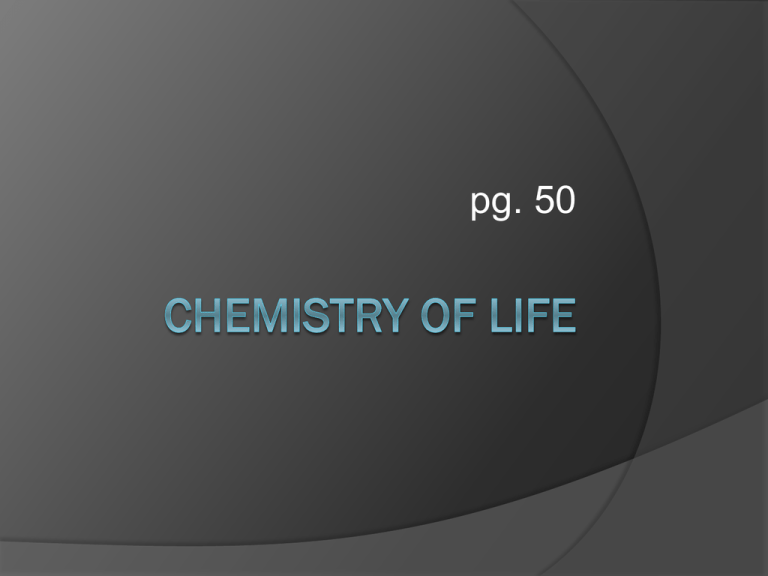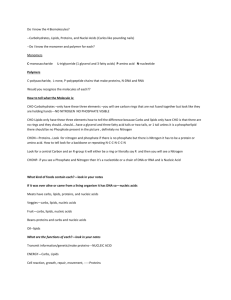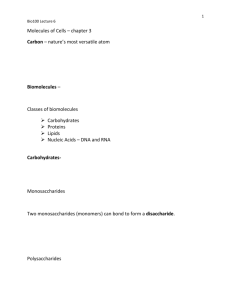chemistry of life notes
advertisement

pg. 50 Elements Element – substance that cannot be broken down into simpler chemical substances Four elements of life There are 4 basic elements that make up 96% all living things: Hydrogen Oxygen Nitrogen Carbon HONC Compounds Compounds – two or more different elements NaCl – sodium and chlorine (table salt) Mixtures and Solutions Mixture – substances are combined, but keep their own properties (sand and sugar) Solution (homogenous mixtures) – one substance is dissolved in another, can be separated by distillation (water and sugar) Review: Mixtures and Solutions kool-aid is an example of a: _________ Colors of M&M’s is an example of a: __________ pH pH – a measure of how acidic or basic something is Acids and Bases Acid – substance with a pH below 7 Base – substance with a pH above 7 A solution is neutral if the pH is exactly 7 Mini-Quiz 1.) An orange has a pH of 4, acid or base? 2.) A battery has a pH of 2, acid or base? 3.) Soap has a pH of 9, acid or base? 4.) Sugar in tea is a mixture or solution? 5.) Salt and pepper is a mixture or solution? 6.) What does HONC stand for? Quiz 1. 4 elements of life: Hydrogen, carbon, _________, _________ 2. You stir together flour and sugar for a cake. What is this an example of? 3. An orange has a pH of 6.3. Is this an acid or base? 4. CO2, H2O, and NO2 are examples of ___________ 5. Give 2 examples of a starch: 6. What are the 4 biomolecules of life? 7. What do proteins make for your body? 8. What pH is neutral? 9. _________ changes the rate of a chemical reaction. 10. Why are lipids important to living things? Review (pg. 15) The 5 Characteristics of Life The 5 steps of the Scientific Method Hypothesis Homeostasis Reproduction Adaptation The different between a mixture and a solution The difference between an acid and a base The 4 basic elements (HONC) The 4 important biomolecules and why they’re so important to living things Starch/Cellulose Enzymes Pg. 51 Carbohydrates 1.) Carbohydrate – a sugar, starch, or cellulose that is a source of energy for an animal or plant Monomer- Saccharides Starch – used to store energy in plant cells (like potatoes) that we can eat to get carbs Glucose/Fructose – complex sugars List 5 sources of carbohydrates: Cereal Bread Desserts Rice Pasta, macaroni Potatoes French Fries Beans Pancakes Cake Carb Diets (Facts) Carbs are only needed if you’re doing LOTS of athletic activities. Otherwise, you can get your daily energy from protein. There are good carbs, like from fruits, veggies, and whole grains. Starchy carbs from potatoes, bread, and rice are harder to burn. Watch empty carbs. Soda’s and cookies that have carbs are adding extra pounds with no energy given to your body. carbohydrates Lipids 2.) Lipids – fat, oil, wax, steroids are all lipids - can’t dissolve in water! Important: they store energy, keep us warm, and protect organs List 5 sources of lipids: Cooking oil Fried foods Egg yolk Whole milk Junk food Medical steroids Illegal steroids Cheese Fat Facts Check labels for the word Hydrogenated, these are very bad and lead to heart problems Limit saturated fats like fatty meats and whole milk Calories are the best thing to watch, not carbs. Very fatty fried foods are low in carbs, but very high in calories Lipids video Nucleic Acids 4.) Nucleic acid – stores cellular information in a code The most common nucleic acids are DNA and RNA List 5 sources of nucleic acids: Any living (or formally living) thing! Meat Plants video NucleicAcids Proteins 3.) Protein is an important part of every cell in the body. Hair, claws, horns, nails are made of protein. Your body uses protein to build and repair tissues. Protein is an important building block of bones, muscles, cartilage, skin, and blood. Some hormones are proteins Amino acids- Monomers of proteins There are 20 amino acids They combine to form all of the proteins. Enzymes Enzymes - important proteins, change the rate of a chemical reaction (speed up) Enzyme-substrate interaction Enzyme activity . enzymes List 5 sources of Proteins Chicken Steak Fish Ham Bacon Sunflower seeds Peanuts Peanut butter Pork chop Protein Facts The best protein is found in fish, chicken, nuts, and beans Red meat (like steak) often has too much fat to make the protein worth it Eating protein doesn’t automatically make muscle. Exercise makes muscle, protein provides the fuel. You should eat around 5-6 ounces, 7 ounces if you’re building muscle. Video Proteins Quiz 1. Which carbohydrate has two sugars? 2. You stir together flour and sugar for a cake. What is this an example of? 3. An orange has a pH of 6.3. Is this an acid or base? 4. Give two examples of a starch. 5. Name one reason why lipids are important? 6. List the 4 biomolecules of life. 7. Name one reason proteins are essential to life. 8. CO2, H2O, and NO2 are examples of ___________ 9. What does cellulose form? 10. List the 4 basic elements of living things. pg. 36 Water Water is sticky! Water molecules hold onto each other very tightly They do this using a hydrogen bond Water Bonds Most important: allows water to creep up small tubes, like plant stems ○ Even the tallest trees get water Diffusion Diffusion – movement of particles from an area of higher concentration, to an area of a lower concentration Diffusion Diffusion is slow because it relies on random movements After a while the substance becomes balanced in both areas, then diffusion stops Diffusion in life Diffusion is one of the ways cells move things in and out of the cell Cell’s Selectively permeable – the cell membrane allows some things in and keeps other things out Uses diffusion! Diffusion Examples 1. 2. 3 Examples: Purfume Smell of food Atoms Atoms – smallest particle of an element The basic building blocks of all matter Parts of an Atom Nucleus – the center of an atom, it is made up of: Protons – positively charged particles Neutrons – particles with no charge Electrons – circle around the nucleus, are negatively charged Parts of an Atom Electron Nucleus -- protons -- neutrons







